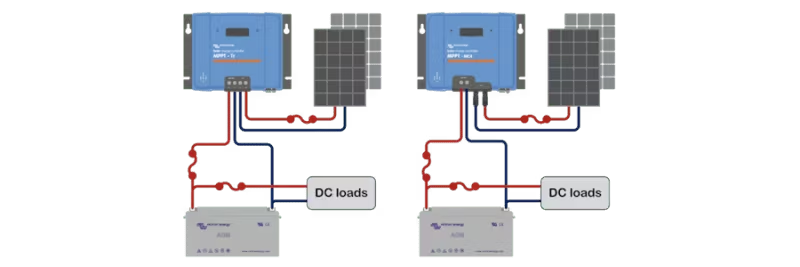Cart
Discount: 0.00 EUR
Discount: 0.00 EUR
Digital Skipper |4/02, 2025

For many, securing electrical equipment is a given, but when it comes to solar energy, there are some common mistakes. In this guide, we clarify these so you can create a safe and efficient solar energy system.
Solar energy is secured at three points before it is consumed: between the solar panels and the controller, between the controller and the battery, and finally between the battery and the consumer. Here we focus on how to secure from the solar panels down to the battery.
Securing between the controller and the battery is easy because the manual specifies which fuse size to use. A smart choice is an automatic fuse that can "trip" – perfect for cutting power during maintenance and installations. Automatic fuses can be reset after tripping, saving time and money compared to traditional fuses.
We offer suitable fuses as accessories for all SmartSolar controllers. See our guide below for recommendations.
This fuse is crucial to protect the controller if the panel is damaged. Many miss installing this fuse. Sizing is more complex because it depends on the panel configuration.
One panel: Check the panel's max current (A) and choose a fuse that is 1.5–2 times this value. Here too, an automatic fuse with trip function is a good choice.
Multiple panels: Calculate the max voltage and current for the entire group. The fuse must withstand the voltage and be sized to 1.5–2 times the max current.

Voltages are added, current remains the same:
Formula:
V_total = V1 + V2 + V3 ...
I_total = I1 = I2 = I3 ...
Example: 3 panels at 20V, 5A:
V_total = 60V
I_total = 5A
Currents are added, voltage remains the same:
Formula:
I_total = I1 + I2 + I3 ...
V_total = V1 = V2 = V3 ...
Example: 3 panels at 20V, 5A:
I_total = 15A
V_total = 20V
When combining series and parallel connections, perform the calculation in several steps.
For a safe installation, cables must be correctly sized. Parameters that affect this are voltage and cable length (roundtrip). The higher the voltage, the less loss.
Use the Victron Toolkit app to calculate cable cross-section and loss. Aim for a maximum of 3% loss. Perform calculations both between panels and controller, and between controller and battery.
The table below helps you compare models. Always check values in the respective manual.
